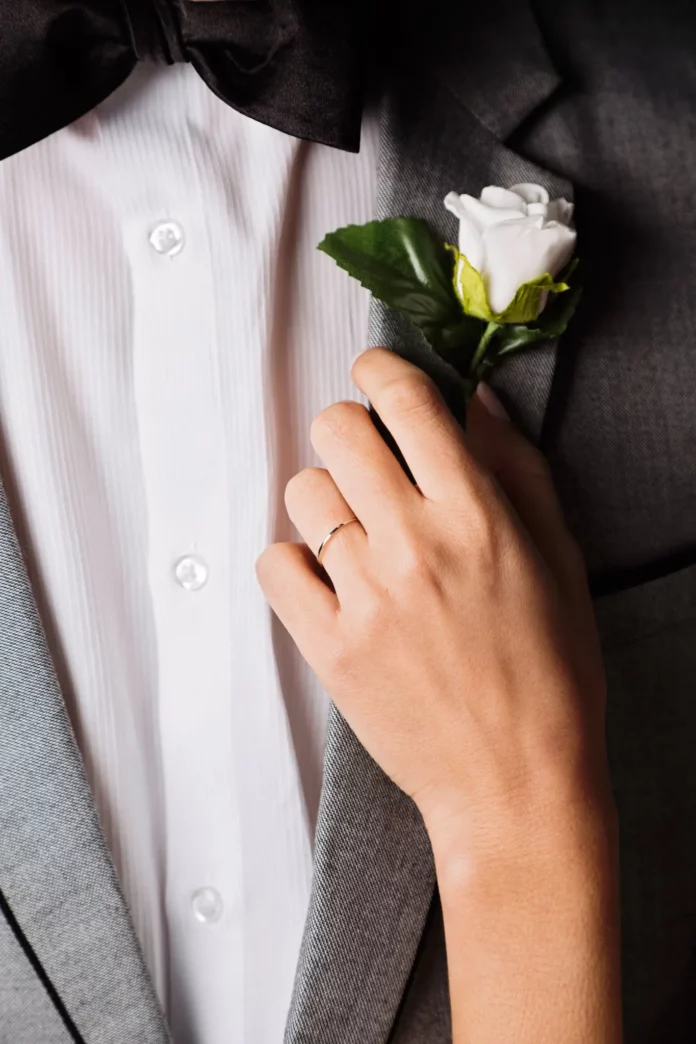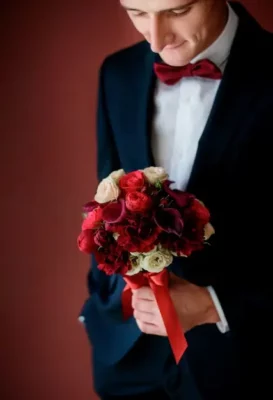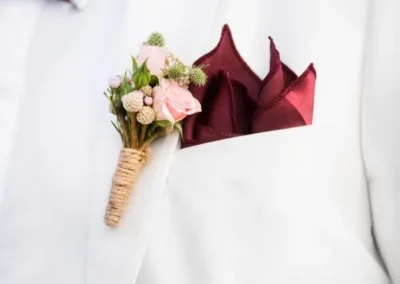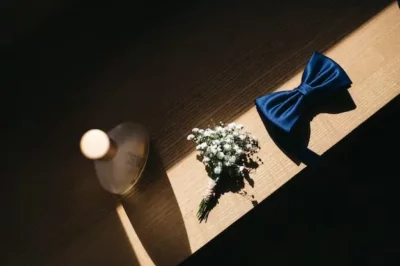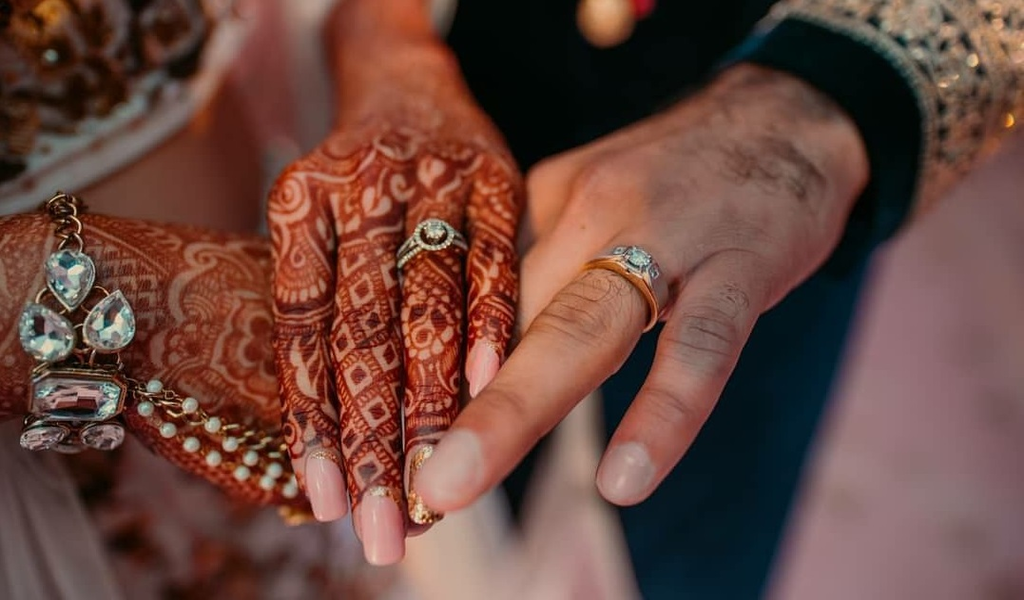Indian weddings are a grand tapestry of tradition, love, and vibrant celebrations. Amidst the myriad details that contribute to this spectacle, the boutonniere adorning the groom’s sherwani often goes overlooked. While the bride’s attire naturally commands attention, the groom’s ensemble, including the boutonniere, should not be underestimated. This guide offers a comprehensive exploration of boutonnieres on sherwanis, delving into their cultural significance, historical roots, diverse styles, personalization options, and tips for wearing and maintaining them.
The Cultural Significance of Boutonnieres
Boutonnieres, also known as “phoolon ki chadar” or “sehra,” hold profound cultural and symbolic importance in Indian weddings. Traditionally, these small but meaningful accessories symbolize the groom’s commitment to protecting and cherishing his bride throughout their shared journey. They stand as symbols of honor, love, and deep respect.
Tracing Boutonnieres Through Time
The boutonniere’s history is a fascinating journey. It has been an integral part of Indian wedding traditions for centuries. Initially, it served a practical purpose, helping grooms distinguish themselves on their big day. Over time, boutonnieres have evolved from simple floral arrangements into intricate and personalized designs.
Exploring Unique Boutonniere Styles
Boutonnieres for sherwanis offer a rich array of styles to choose from. Beyond the classic options, consider the following unique ideas:
- Botanical Wonders: Instead of conventional flower choices, explore exotic and uncommon blooms that reflect your personality and style. Embrace rare blossoms that go beyond the ordinary, creating a statement that is uniquely yours.
- Cultural Fusion: Blend elements from different Indian cultures into your boutonniere. Combine North, South, East, or West Indian motifs to pay homage to your diverse heritage. Let your boutonniere be a fusion of the rich traditions that shape your identity.
- The Essence of Aroma: Infuse your boutonniere with fragrant herbs and spices like basil, rosemary, or cardamom. Not only will this add a delightful fragrance to your ensemble, but it will also engage the senses in a memorable way.
Personalizing Your Boutonniere
Personalization is key to crafting the perfect boutonniere. Consider these avenues for making your boutonniere truly yours:
- Expressive Elements: Incorporate symbols or motifs that hold personal significance for you and your partner. Whether it’s your initials, zodiac signs, or a representation of your unique love story, these elements can add depth and sentiment to your boutonniere.
- Family Heirlooms: If you have family heirlooms or meaningful objects, consider integrating them into your boutonniere design. This adds a layer of history and nostalgia to your attire, making it more special.
- Seasonal Elegance: Align your boutonniere with the season of your wedding. Incorporate seasonal elements like dried leaves for an autumn wedding or fresh blossoms for a spring celebration. This not only complements the ambiance but also adds a touch of seasonal charm to your look.
The Art of Wearing a Boutonniere
Wearing a boutonniere on your sherwani is an art that requires finesse. Here’s a step-by-step guide with a twist:
- Asymmetric Appeal: Instead of placing your boutonniere in the traditional center of your lapel, try positioning it slightly asymmetrically. This contemporary touch adds an unexpected and stylish element to your ensemble.
- Multifunctional Accessory: Opt for a boutonniere that serves a dual purpose, such as a brooch or a pin. This not only adds a unique aspect to your attire but also offers functionality.
- Unity in Diversity: Symbolize the union between you and your partner by incorporating elements from both your backgrounds into your boutonniere. Let it be a representation of your coming together as a couple.
Maintaining Your Boutonniere’s Freshness
Ensuring your boutonniere looks fresh throughout your wedding day is essential. Consider these tips:
- Fragrant Refresh: To keep your boutonniere smelling fresh and inviting, spritz it with a light fragrance that complements your personality and style.
- Natural Elements: Incorporate sustainable and natural materials into your boutonniere. Bamboo, twine, or dried flowers not only look distinctive but also reduce the environmental impact.
- Living Keepsake: Choose a living boutonniere, such as a succulent or a small potted plant. After the wedding, plant it as a symbol of your love growing and thriving, nurturing it as you do your relationship.
Capturing the Moment
Your boutonniere is more than an accessory; it’s a story waiting to be captured in your wedding photos:
- Close-Up Magic: Request your photographer to capture close-up shots of your boutonniere, highlighting its intricate details and the unique elements you’ve incorporated.
- Candid Charm: Include candid moments where you interact with your boutonniere. These shots capture genuine emotions and memories associated with this special accessory.
Conclusion
In the grand canvas of an Indian wedding, the boutonniere on the groom’s sherwani may seem like a small detail, but its significance is profound. It symbolizes love, commitment, and the groom’s devotion to his bride. By selecting the perfect boutonniere, you enhance your sherwani’s allure and create enduring memories of your special day.
Your wedding day is a celebration of love, culture, and individuality. Every detail, no matter how small, contributes to the beauty of the moment. As you stand beside your bride, adorned in your meticulously crafted sherwani with a boutonniere that tells a unique story, you embody the rich tapestry of Indian weddings.
Embrace your boutonniere selection journey with a fresh perspective, for it is your secret weapon, adding an element of uniqueness and charisma to your path towards marital bliss.





